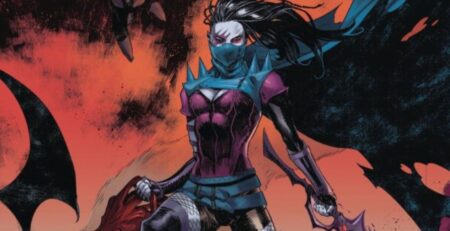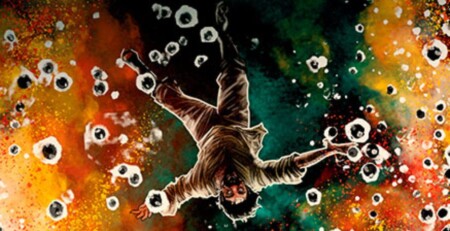Speed Racer Issue 1 is published by Mad Cave Studios. Written by David Pepose, art by Davide Tinto, colors by Rex Lokus, and letters by Buddy Beaudoin.
Reimagining the classic cartoon, a young racer named Speed is desperate to race in the prestigious Formula X series, but his home life is weighing him down.
This first issue of a brand new series requires zero knowledge of existing stories or characters, completely resetting and starting from the beginning. Speed Racer Issue 1 rapidly brings readers into a fascinating and frenetic concept, with a race taking up much of the opening half of the comic. It shows the energy that will be seen in the series, as well as shocking the system, before slowing down and showing the negative posts of the story. Speed shows how talented he is as a driver, but his circumstances are dark as his father forbids him from racing.
Even the more stationary moments, such as when Speed and his dad are arguing, are exciting. Pepose’s storytelling is incredible, constantly keeping the book moving and maintaining a sense of danger and intensity.
It’s a great origin story, almost classic in a superhero sense. Racing goes from being a passion to a necessity. There are two action scenes in Speed Racer Issue 1, and the second is even more exciting than the first. More is hanging over it with higher stakes and even more dangerous consequences.
The characters are terrific, brilliantly explored even at this early stage. As someone not familiar with the world of Speed Racer, it’s very easy to become interested and understand what they stand for. There’s Speed, a typical but captivating hero. He is cocky, talented, and fierce, determined to reach stardom by any means necessary. He has extreme confidence, whether that be with a wheel or with a woman. That puts him into conflict with his father. Speed’s dad is also superbly written.
In the first blisteringly angry confrontation with his son, the patriarch and only parent could be seen as mean and even abusive. But it becomes clear that his refusal to let Speed race is out of concern and deep grief, instead of hostility. The moment of lonely vulnerability in the aftermath of the argument is beautiful and touching. Then there’s Spritle, Speed‘s younger brother and sidekick. He’s young, but he has an eye for business and making money.
And around this family core, there’s the other supporting cast that rounds out Speed Racer Issue 1. It makes the comic lively and full of voices, which boosts the already enthralling energy. The dialogue is rich and relatable, which is very important in the racing. There isn’t just spoken dialogue to explain what’s happening, but captions that explain the inventions and technology in the cars that give them advantages in the race. These explanations are brief and unobtrusive, not as in-depth as classic superhero books. Instead, Pepose does trust the quality of the art to tell the story.
The art is exceptional, adapting something that isn’t exactly easy to capture in comics. Racing, like other sports, is so physical and based on movement that it can be difficult to show on paper. But Speed Racer was a manga first, so there is a precedent for it. Tinto is excellent at illustrating the races and everything else within Speed Racer Issue 1.
The design of the cars and their upgrades is fantastic, showing the frantic and zany nature of the races. There are guns, cannons, shields, and other technology. The cars go up walls, through buildings, and anywhere they can to win. Tinto displays the cacophony and the chaos, but crucially, the clarity too. You can tell exactly what’s happening at any point.
There’s a fantastic movement to Speed Racer Issue 1, with the cars hurtling through the city and leaving carnage in their wake. But there is also superb art during the moments when the characters are standing still, too. The anger, pain, and more precise emotions during fraught fights are sensational. The characters also look faithful to their classic counterparts, making them easy to recognize.
The colors make the characters and their cars the stars of the show. Their clothes and car liveries are covered in bright red and blue, but not so vibrant as to look out of place. Because the rest of the work is relatively calm and muted, save for some bright streetlights. In the flashbacks, which explore the similarities between Speed and his older, deceased brother, Rex, there is more brown and beige.
This is not only to separate the flashbacks from the present and place them firmly in the past, but to add a sad and doomed tone to the panels. The lettering is exceptional, especially the captions that explain the gadgets and upgrades. It’s not only helpful, but the ridiculousness of what comes out of the cars is part of the charm.
Speed Racer Issue 1 reignites the spirit of a classic series. This adaptation is near flawless, reinvigorating a world that is just so much fun. The racing is delightful, the characters are meaningful, and the plot has heart, charm, and weight. David Pepose is a fantastic choice, already proving his ability to turn cartoons into comics with Space Ghost and Captain Planet, and the art team turns the racing into a true spectacle. For old fans who want to reminisce or readers who want to discover something new, this series is welcoming to all.
Speed Racer Issue 1 is available where comics are sold.
Speed Racer Issue 1
TL;DR
Speed Racer Issue 1 reignites the spirit of a classic series. For old fans who want to reminisce or readers who want to discover something new, this series is welcoming to all.








